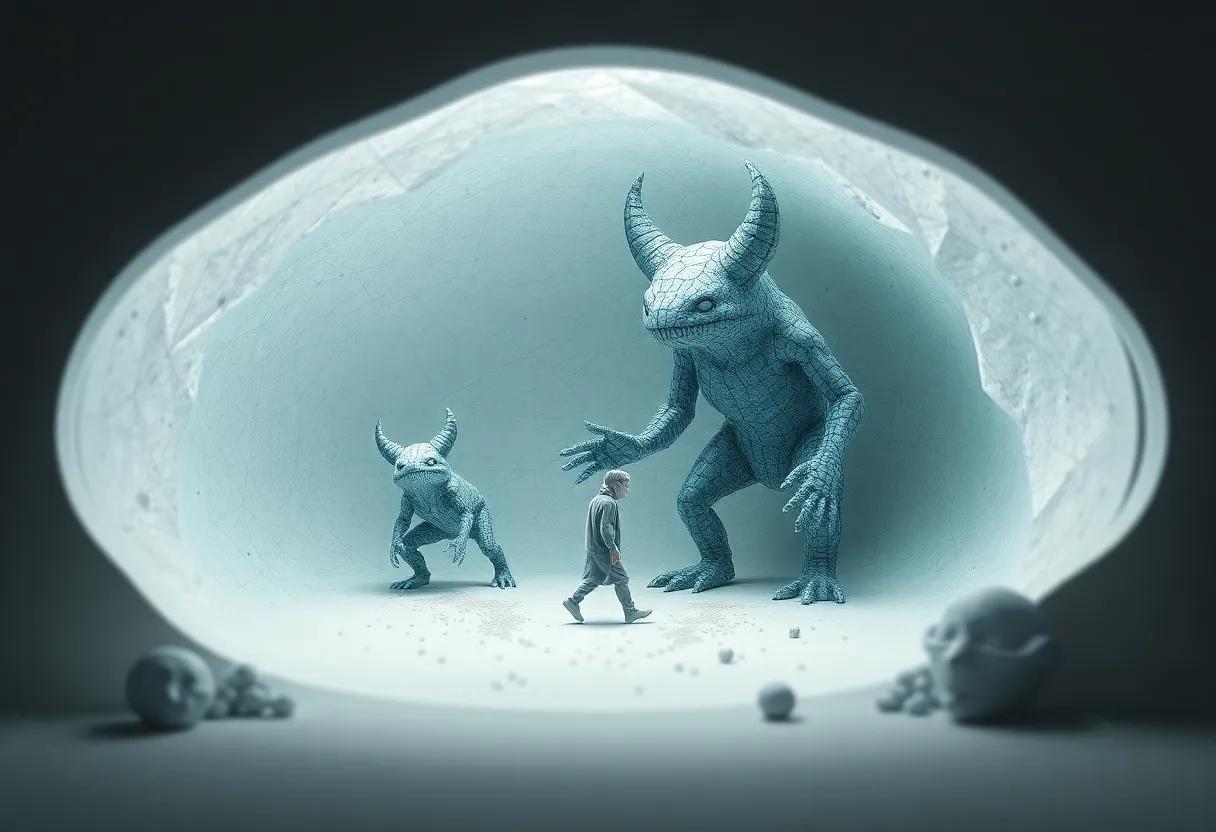In the realm of young adult fiction, few authors navigate the intricate tapestry of identity and conversion as adroitly as Scott Westerfeld. His novel “Peeps” serves as a vivid lens through which we explore the multifaceted nature of selfhood, interweaving themes of love, loss, and the allure of the unknown. In this compelling narrative, Westerfeld invites readers into a world where vampires are not merely figments of folklore but catalysts for profound personal change. Through the eyes of his protagonist, we embark on an exhilarating journey that challenges the boundaries of human experience and societal norms. In this review, we will delve into the rich textures of character development, thematic depth, and the underlying questions of what it truly means to transform in an ever-evolving world. Join me as we unravel the layers of “Peeps” and discover the haunting truths that lie within its pages.
Unraveling the Tapestry of Identity in Peeps

In Scott Westerfeld’s Peeps, identity is not just a matter of self-perception; it’s a complex interplay between biology, culture, and personal transformation. The protagonist, Cal, embodies a struggle between his humanity and the parasitic influence of the “peep” virus, which alters behavior and identity. This internal conflict raises profound questions about the essence of self: Are we defined by our instincts and biology, or do our choices shape who we are? Throughout the narrative, the characters grapple with their identities, influenced by the societal lens through which they are viewed. Their transformations lead to an exploration of varied identities that extend beyond the binary of human and monster, revealing the multiplicity inherent in every individual.
Westerfeld cleverly maps the evolution of identity through the relationships and experiences intertwined in the plot. As characters navigate the chaotic world of the infected, they encounter crucial moments that force them to confront their fears, desires, and the masks they wear. This journey is mirrored in:
- Fear and Acceptance: The fear of being different and the eventual acceptance of one’s true self.
- Friendship and Betrayal: the bonds that either elevate or diminish one’s sense of identity.
- Science and Myth: How modern science challenges age-old myths about what it means to be human.
through these themes, westerfeld constructs a layered narrative that prompts readers to question their own identities in a world of ever-shifting definitions. The following table summarizes the key transformative moments in Peeps:
| Character | Transformation | Identity Shift |
|---|---|---|
| Cal | infected but evolving | Human to “peep” protagonist |
| Mary | Discovering her true desires | From naive to empowered |
| SL | Torn between loyalty and self-preservation | Friend to traitor |
In essence,Peeps challenges readers to interrogate the nuances of their own identities,leveraging the fantastic to reflect on the very real complexities of being human. It serves as both a thrilling tale and a thought-provoking commentary on how identity is woven from the threads of experience,belief,and biological imperatives.
The Duality of Transformation: Monsters and Humans

In Scott Westerfeld’s “Peeps,” the line between monster and human is perpetually blurred, illustrating the intricacies of identity and transformation. The protagonist, Cal, is not simply a victim of the vampiric infection but also a vessel for transformation, encapsulating the duality of what it means to be human in the face of monstrous metamorphosis. As the narrative unfolds, we witness that the characteristics traditionally assigned to monsters—predation, darkness, chaos—begin to reveal a deeper layer of humanity. Cal grapples with his newfound powers while attempting to manage the psychological and societal stigma of his ‘monster’ state. This interplay raises profound questions about self-acceptance and the search for one’s true self amidst external perceptions and internal fears.
Moreover,Westerfeld introduces an array of memorable characters,each presenting their own struggles with identity. from the seductive allure of Peeps who embody both predator and prey, to the morally ambiguous figures guiding Cal, we see how transformation can serve as both a curse and a catalyst for growth. The following table highlights key characters and their conflicts:
| Character | Conflict | Transformation |
|---|---|---|
| Cal | Struggles with his vampiric nature | Embraces dual identity |
| Lis | Dealing with her infection | Transitioning from human to ’Peeps’ |
| Morrigan | Seeking control over her predatory instincts | Crafting her own narrative |
This duality creates a complex exciting tapestry that encourages readers to reflect on their own perceptions of what it means to ‘be human.’ As transformation captures the essence of these characters, it invites us to ponder our own identities, the monsters we harbor within, and the potential for redemption and growth amidst the chaos of change.
A Glimpse into the Dark: The Vampire Epidemic’s Symbolism

The vampire epidemic in scott Westerfeld’s “Peeps” serves as a rich metaphor for the complexities of identity and transformation. as the characters grapple with their newfound powers and the horrifying implications of their condition, we witness a striking commentary on the human experience. The infection symbolizes the fear of change and the loss of self, as individuals transition into something other—ofen against their will. This transformation highlights how identity can be both a source of empowerment and a site of conflict, revealing the diverse emotional landscapes people navigate when faced with drastic life alterations.
Moreover, the implications surrounding the vampire epidemic extend beyond the supernatural realm, inviting readers to reflect on societal perceptions of difference and otherness. By showcasing how these transformations affect both personal relationships and broader social dynamics, Westerfeld illustrates a landscape where fear often breeds misunderstanding. Notably, the characters’ struggle to maintain their humanity amidst their monstrous transformation raises questions about the essence of identity. Key themes include:
- The duality of human nature
- The fear of losing oneself
- The struggle for acceptance
- Transformation as both curse and blessing
| Theme | symbolism |
|---|---|
| Fear of Change | Infection as loss of control |
| Identity Crisis | The struggle between human and vampire instincts |
| Acceptance | Connecting with others despite differences |
| Power Dynamics | Transformation leading to new hierarchies |
character Evolution: Navigating Growth in Uncertain Times

In the gripping narrative of Scott Westerfeld’s “Peeps,” character evolution becomes a journey marked by the interplay of fear, revelation, and the innate desire for connection. As the protagonist grapples with the transformation into a ‘Peeps’, they encounter a reality where the familiar becomes foreign. This metamorphosis highlights the struggles related to identity in uncertain times, showcasing how societal pressures and personal demons expand the boundaries of who we are. The protagonist’s shifting sense of self mirrors the complexities faced by many today, reflecting the theme that growth often emerges from chaos.
Moreover, Westerfeld illustrates the concept of identity through a diverse cast of characters, each navigating their own transformations. The complexities of these arcs can be summarized effectively through the following attributes:
| Character | Initial Identity | Post-Transformation |
|---|---|---|
| Cal | Normal Teen | Peeper |
| Desmond | follower | Leader |
| Mari | Innocent Bystander | Active Participant |
This table eloquently encapsulates the essence of transformation that each character undergoes, representing a spectrum of growth amidst adversity. Each evolution serves as a reminder that identity is fluid, shaped by experiences and choices, especially in times of uncertainty. The diverse paths taken by these characters inspire readers to reflect on their own journeys, prompting questions about who they are and who they can become in the face of life’s challenges.
Societal Reflections: Identity Crisis Within the Urban jungle

In the heart of towering concrete structures and bustling streets, identity often becomes a blurred concept—a reflection of the myriad personalities we adopt in our ever-evolving urban existence. Scott Westerfeld’s ’Peeps’ beautifully encapsulates this modern struggle, presenting characters who oscillate between their true selves and the façades they wear to navigate the chaotic metropolis. The intertwining of personhood with the notions of transformation and alienation showcases how urban environments can intensify the quest for identity. Within this urban jungle, one might feel like a mere peep-show spectator, observing the complex dynamics of society, yet devoting little attention to their own evolving identity.
As our protagonists grapple with their vampiric transformations,they symbolize a broader commentary on how societal pressures can force individuals into ‘masks’ of conformity,often leading to a profound identity crisis. In ‘Peeps,’ we see:
- Isolation vs. Community: Characters cling to their distinctiveness while yearning for belonging.
- Evolution vs. stagnation: The definition of self provides both liberation and entrapment in the urban expanse.
- Reality vs. Facade: each encounter in the city reveals layers not only of the world but of the self.
| Character | Identity Struggle | Urban Symbolism |
|---|---|---|
| Cal | Discovering his new nature as a ‘Peeps’ | Metropolis as a reflection of chaos |
| Lis | Striving for authenticity in a superficial world | Social circles as layered identities |
Cinematic Imagery: The Visuals that enhance the Narrative

The world of Peeps is brought to life through a masterful use of cinematic imagery that plays a critical role in conveying the nuances of identity and transformation. Westerfeld expertly crafts scenes that evoke sensory experiences, immersing readers in the gritty streets and shadowy corners of a city teeming with secrets. Vivid visuals transport us to the moment when characters undergo transformative trials,making palpable their struggles and triumphs. Through imagery, the transformation of the protagonist is not just told but felt, allowing readers to experience the emotional weight of each change. The interplay of light and darkness becomes a powerful metaphor, accentuating not only the physical changes the characters undergo but also the deeper emotional and psychological shifts they encounter on their journey.
Consider the following visual elements that are essential in enhancing the narrative of Peeps:
| Visual Element | Meaning |
|---|---|
| Urban Landscape | Reflects the chaotic nature of the protagonist’s mind. |
| Color Palette | Symbolizes emotions; dark hues denote despair, while luminous colors hint at hope. |
| Body Language | Illustrates character development and internal conflict. |
| Symbolic Objects | Reinforce themes of identity, such as mirrors for reflection. |
Such visual representations allow for a rich exploration of themes that resonate deeply with readers. The use of close-up shots—imagined in the reader’s mind—of characters struggling with their new realities, contrasted with wide shots of the vast cityscape, serves to heighten the sense of isolation and urgency. In a way, these visuals create a dual narrative, where the external environment mirrors the internal battles of the characters, thus enhancing the overall storytelling experience. this synergy between the visual and the narrative fabricates a compelling canvas that amplifies the emotional resonance of Peeps and invites readers to not just observe but engage intimately with the evolving identities that lie within its pages.
Interconnected Lives: The Role of Relationships in Self-Discovery

In Scott westerfeld’s Peeps, relationships serve as a profound lens through which characters explore their identities. Each connection, whether forged in friendship or animosity, acts as a catalyst for self-discovery, pushing protagonists to confront their fears, desires, and the essence of what it means to be human. Through their interactions,characters navigate a landscape of dualities—light and darkness,humanity and monstrosity—forcing them to question their own beliefs and moral compasses. This journey illustrates the intertwining of personal growth with external influences, as each bond reflects not only the characters’ individual transformations but also the impacts of societal perceptions and relationships on their sense of self.
The dynamic interplay among characters unveils how external relationships deeply shape internal transformations. As they delve into their fears and desires, they begin to recognize key themes that resonate throughout their experiences:
- Empathy: Understanding others‘ experiences helps uncover hidden aspects of oneself.
- conflict: Struggles with others frequently enough mirror internal battles, pushing characters toward self-awareness.
- Support: Relationships provide a foundation that encourages exploration and acceptance of one’s identity.
Thus, Westerfeld emphasizes that self-discovery is not a solitary pursuit but a tapestry woven from the threads of interconnected lives. The characters’ journeys illuminate how intertwined they are, shedding light on the complexity of identity in a world where every relationship has the potential to spark transformation.
The Science of Vampirism: Melding Fact and Fiction

In Scott Westerfeld’s novel, the intricacies of vampirism are explored through a unique lens, combining elements of biology, psychology, and folklore.Vampires are often perceived through the prism of mythology and horror, yet Westerfeld ingeniously attributes a scientific basis to their transformation. The tale unveils the concept of parasitic organisms acting as the catalyst for this transformation. This intertwining of fact and fiction compels readers to ponder the fine line separating myth from reality. The protagonist, Cal, grapples with his new identity as a “peep” (an acronym for Parasite-Positive), emphasizing the internal conflict faced by those navigating profound changes brought on by external influences—be they biological, social, or psychological.
Westerfeld’s exploration dives deeper, delving into the psychological effects of such transformation. The newly infected must contend with a loss of agency and the potential for violence in their newfound existence, echoing the societal fears associated with the unknown. This examination lends itself to a broader discussion about identity and the essence of humanity when faced with drastic changes.The following table highlights key aspects that define the transformation into a “peep,” offering insight into both the physiological and sociological implications:
| Aspect | Transformation Impact |
|---|---|
| Physical Changes | enhanced senses, craving for blood |
| Mental State | Duality of behavior; can be predatory |
| Social Perception | stigmatization and fear from society |
| Identity Crisis | Questioning one’s humanity and morals |
Cultural Commentary: Examining Modern Youth and Choices

In Scott Westerfeld’s Peeps,we witness a vivid tapestry of modern youth grappling with their identities as they navigate the complexities of transformation in a world saturated with choices. The protagonist, a young man caught in a web of viral infection, serves as a metaphor for the pressures faced by today’s youth. As they confront their desires, fears, and societal expectations, these young characters embody the struggle between individuality and conformity.The narrative cleverly intertwines themes of loyalty, desire, and the acknowledgment of one’s darker impulses, urging readers to reflect on how external influences shape personal choices.
Moreover, the novel delves into the notion of connection amidst isolation, echoing the challenges faced by contemporary youth. In an era marked by digital communication, the importance of genuine relationships becomes paramount. Westerfeld illustrates how bonds—be they friendships or romantic partnerships—serve as anchors in a world rife with uncertainty. The characters’ journeys highlight critical reflections on their decisions, illustrating the paramount role of choice in crafting one’s identity. As they confront the ramifications of their actions, readers are invited to ponder the delicate balance between embracing one’s true self and adhering to the roles imposed by society.
Themes of Acceptance: Embracing Unconventional identities
In Scott Westerfeld’s “Peeps,” the themes of acceptance and embracing unconventional identities unfold against a backdrop of transformations that challenge societal norms. At the heart of the narrative lies a community of young individuals grappling with their newly acquired identities due to a vampiric infection. Instead of shunning these changes, the characters learn to navigate their transformed states with resilience and humor. Their journey is marked by an understanding that identity is not fixed, but fluid, encouraging readers to question preconceived notions of what it means to belong.
The novel intricately explores how friendship and community serve as powerful tools for acceptance, especially in the face of adversity. As the characters bond over their shared experiences, they redefine what it means to be “normal.” Consider these pivotal aspects of their evolving identities:
- Community Support: The characters find strength in solidarity, fostering an environment where differences are celebrated.
- Reimagining Normalcy: Their transformations prompt a rethinking of societal standards, showing that unconventionality can lead to empowerment.
- Self-Discovery: Amidst the chaos, each character uncovers deeper layers of their true selves, embracing identities that thrive beyond mere labels.
Engaging the Reader: Techniques that Capture Attention

In Scott Westerfeld’s ‘Peeps’, the reader is instantly drawn into a world that intertwines the complexities of identity with the visceral pangs of transformation. Westerfeld employs various techniques to captivate the reader’s attention, such as vivid imagery and relatable character arcs. Through these elements, readers find themselves immersed in a narrative that feels both foreign and familiar. The use of first-person narrative allows readers to connect deeply with the protagonist’s journey, experiencing every twist and turn intertwined with themes of fear and discovery. Moreover, cliffhangers at chapter endings maintain a suspenseful atmosphere, encouraging readers to turn the page in anticipation.
Additionally, the inclusion of scientific details not only enhances the narrative’s authenticity but also piques curiosity. readers are pushed to question the boundaries of reality versus fiction, leading to deeper engagement. To illustrate the impact of these techniques, consider the following table, which highlights key aspects that contribute to a captivating reading experience:
| Technique | Description | Impact on Reader |
|---|---|---|
| Imagery | Vivid descriptions that paint a picture | Increases immersion in the story |
| Relatable Characters | Character struggles that mirror real-life issues | Fosters empathy and connection |
| Cliffhangers | Suspenseful endings that prompt further reading | Keeps readers invested in the plot |
| Scientific Elements | Integration of facts and theories | Stimulates curiosity and critical thinking |
A Journey Through Fear and Strength: Emotional Resonance

In Scott westerfeld’s ‘Peeps’, fear manifests not just as a haunting specter but as a catalyst for transformation.The protagonist’s journey is marked by a profound confrontation with his own vulnerabilities, which allows for an exploration of personal strength amid chaos. This gripping narrative weaves a tapestry of emotions where characters grapple with the horror of vampirism—a symbolic representation of the primal fears that lurk within us all. As they navigate through the intricacies of their changing identities, the oscillation between fear and empowerment highlights the duality of human experience.
The emotional resonance deepens with the interplay of fear and strength, prompting readers to reflect upon their own struggles and metamorphoses. Key themes emerge, illustrating how individuals respond to fear in varied ways, ultimately leading them towards enlightenment and resilience. This resonates universally, almost as if whispering that, in the face of our darkest moments, we hold the capacity to emerge stronger. Below is a table summarizing the themes woven throughout the narrative, reminding us of the connections between fear, identity, and transformation.
| Theme | Description |
|---|---|
| Fear of the Unknown | How fear acts as both a barrier and a gateway to self-discovery. |
| identity Crisis | The struggle to understand oneself amidst external changes. |
| Resilience | The emergence of strength through overcoming fear. |
The Balance Between Darkness and Humor in Storytelling

In Scott Westerfeld’s “Peeps,” the interplay of darkness and humor weaves a narrative that captivates readers while delving into the complexities of identity and transformation. The characters inhabit a world teetering on the brink of chaos, where the humor serves as a coping mechanism, providing moments of relief amidst the grim realities of a vampire epidemic. This juxtaposition of light and dark not only enriches the characters’ arcs but also reflects the multifaceted nature of human experience. As readers, we witness characters grappling with their fears, desires, and ethical dilemmas, enlivened by a witty dialog that often transforms their darkest moments into absurdities that provoke laughter.
The author masterfully balances moments of horror with levity, demonstrating how humor can illuminate the shadowy aspects of existence. This technique draws readers deeper into the psychological dimensions of the characters, encouraging a closer examination of their transformations. As an example, the protagonist’s struggle with his vampiric identity highlights the duality within himself—becoming both monster and hero. The use of quirky subplots and comical side characters further emphasizes this dichotomy, inviting readers to engage with the text on multiple levels. The blending of horror with humor reveals how individuals can navigate through their darkest times by embracing both their fears and their capacity for joy. Here’s a brief look at key themes:
| Theme | Description |
|---|---|
| Identity | The struggle between one’s true self and societal expectations. |
| Transformation | How experiences, both dark and humorous, shape personal growth. |
| Humor | A mechanism for coping with fear and trauma. |
| Darkness | The exploration of moral ambiguity and human nature. |
Celebrating Scott Westerfeld: The Mind Behind Peeps

In Scott Westerfeld’s thrilling narrative, readers are plunged into a world where identity and transformation are not merely themes but essential threads woven into the fabric of the storyline. Through the lens of a unique parasitic infection, Westerfeld explores what it truly means to be human. The protagonist, Cal, undergoes a profound metamorphosis, challenging conventional notions of self. This narrative choice highlights not only the physical changes that come with the transformation but also the psychological turmoil that often accompanies such profound shifts. Themes of survival, belonging, and the quest for self-identity take on new meanings as characters navigate the shifting landscapes of their experiences.
Moreover, Westerfeld masterfully incorporates elements of urban legends and folklore, grounding his fantastical premise in familiar cultural touchstones. The concept of a “peep”—a creature born from an infection that alters consciousness—invites readers to ponder the characteristics that define us. Are we the choices we make, or are we the circumstances thrust upon us? In this rich tapestry, Westerfeld introduces a diverse cast of characters, each embodying different responses to their transformations. A table showcasing these characters reveals their unique journeys:
| Character | Transformation | Identity quest |
|---|---|---|
| Cal | Infected by a parasite | Struggles with his new urges |
| Lisa | Reverts to primal instincts | seeks control over her identity |
| Dr. W. | Pioneering research | explores ethics of human alteration |
Westerfeld’s narrative serves as a mirror reflecting our own fears and desires regarding identity and change, making his work not just a story, but a profound exploration of the human condition. The intricacies of character development paired with rich stylistic choices create a reading experience that lingers long after the pages are turned, inviting a deep contemplation on who we are beneath the surface.
To Conclude
As we close the chapter on our exploration of Scott Westerfeld’s “Peeps,” we find ourselves reflecting not just on the narrative, but on the very nature of transformation that it embodies. Through the lens of its compelling characters and visceral themes, the novel invites readers to confront the complexities of identity, the essence of what it means to be human, and the inherent changes we undergo in the face of remarkable circumstances.
Westerfeld’s ability to weave elements of horror and science with a profound philosophical inquiry leaves us pondering our own metamorphoses. Whether you approach “Peeps” as a thrilling adventure or a deep exploration of self-discovery, it proves to be a rich tapestry of ideas that resonates long after the final page is turned.
As you traverse your own journey of identity and change, let the echoes of this narrative linger in your thoughts, reminding you that transformation is not just an outer experience, but a profound inner evolution. In that spirit, let us carry forward the lessons learned from this dive into the world of “Peeps,” embracing the complexities of who we are and who we might yet become.












